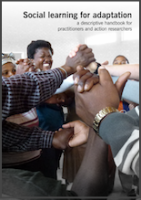

This is a handbook on social learning for adaptation. It is an excellent descriptive handbook for practitioners and action researchers. The authors of this book include Georgina Cundill, Sheona Shackleton, Lawrence Sisitka, Monde Ntshudu, Heila Lotz-Sisitka, Injairu Kulundu, and Nick Hamer. This handbook presents the experience of a participatory social learning process that evolved to support individual and community level adaptation to the myriad of stressors affecting rural people. While the social learning process is presented as a ‘package,’ this is more out of convenience than attempting to represent a perfect model. In other words, genuinely responsive social learning processes may well vary in content, but possibly not in core features from what is presented therein. This handbook should therefore be considered as a framework to guide thinking and reflection around how such processes might unfold, and further provide guidance towards possible approaches and activities that may be appropriate in some circumstances.
The most critical factor emerging through the experience of this social learning process is how facilitators see their roles and their relationships with participants. It is essential to strive for a balance between responsiveness and guidance, achieved through an approach that is open, based on a principal of seeking equality, and one that is fully prepared to follow a path different from the one that may have originally been envisaged. This adaptive approach embraces the concept of co-learning, and was one of the objectives of the social learning processes embarked on in this project. This handbook emerged over the course of four years, during which time facilitators associated with a vulnerability and adaptation research programme set out to support social learning processes in two communities simultaneously. Facilitators did not ‘get it right’ every time, in fact they often got it wrong. However, in a reflexive process such as this, these experiences were used to improve interactions with community members. Here, they try to present not only a process that might assist others who seek to understand local vulnerability and build adaptive capacity in communities, but also some of the key co-learning ‘moments’ experienced along the way in which either the facilitators or the community participants changed their thinking about what they were doing together (co-learning in action).
It is important to remember as you read the handbook that the process was developed as part of a broader scientific research project on vulnerability and adaptation to climate change and other stressors, with a focus on knowledge building. It was led through Rhodes University, not through a development agency, and therefore the focus may be quite different from one arising in a more development-based context. Nevertheless, many aspects of the handbook should resonate within different contexts. Authors believe the handbook will be useful for NGO practitioners who work with communities and seek to build critical apacities, researchers who are interested in processes of action research, social change and co-learning, and government employees who are mandated to support communities in their efforts to collectively overcome hardships.
The handbook is divided into part I and part II. Part I contains 6 chapters.
Chapter 1 is the introduction which covers the background to the book project; how a social learning approach is different to other participatory approaches; Vulnerability and adaptation when the future is uncertain; and why human agency should be supported in addition to identifying technological solutions.
Chapter 2 alludes to the planning stages and process design and ways of engaging with community members which is the introduction of the project and forming the social learning groups.
Chapter 3 presents the co-development of an understanding of the context in which people live, and the challenges that they face.
Chapter 4 is about changing the conversation toward understanding existing activities, aspirations and strengths in the community, shedding light on our role in our community and what groups of people do in our community to help deal with challenges.
Chapter 5 presents ways of building on community strengths and breaking down barriers to adaptation as well as building capacity in and beyond the social learning groups inter alia.
Chapter 6 of the handbook contains concluding thoughts to adopting a reflexive approach. It ends with the provision of additional reading and resources.
PART II of the handbook contains the ‘Problem Solving Course Pack’ which has ‘core course materials’ and ‘support materials’.
To download this book click Social learning for adaptation
